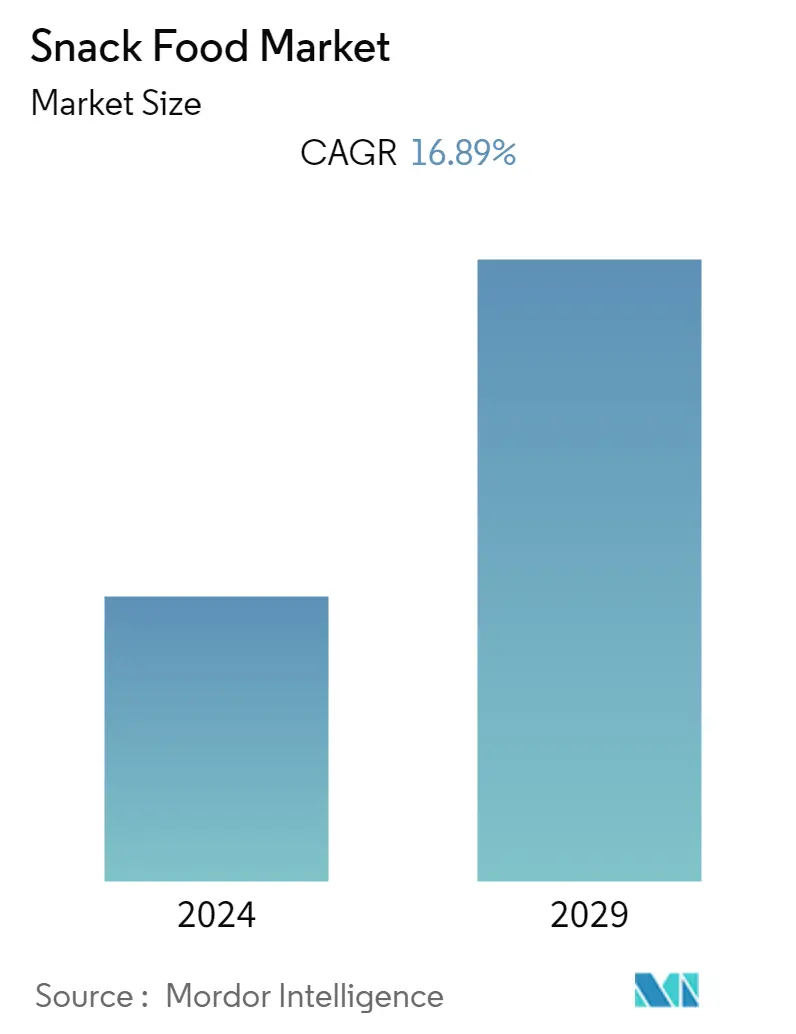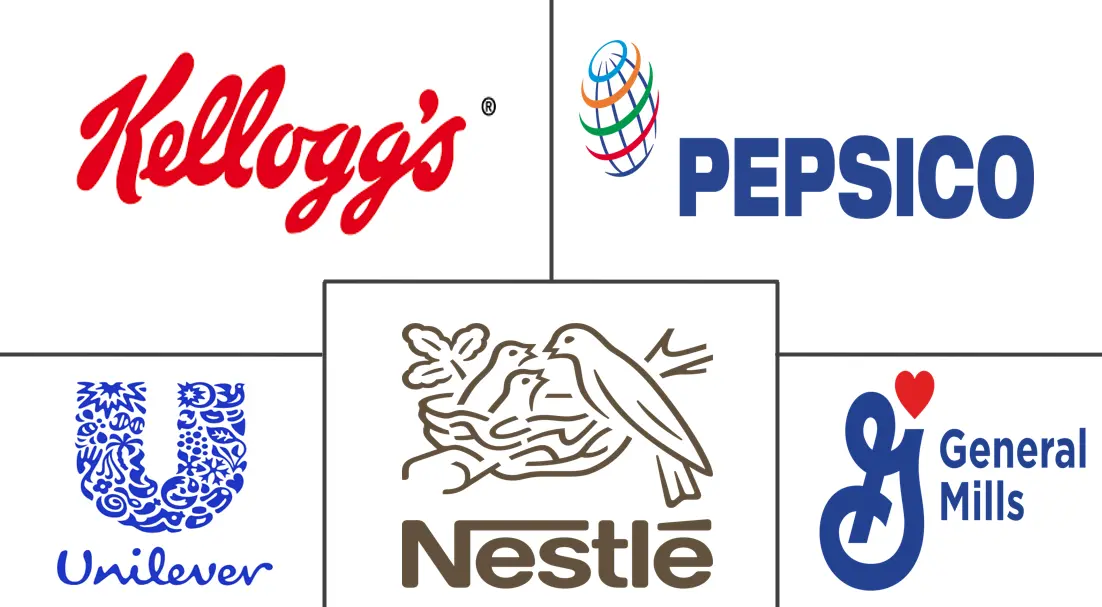Market Size of Snack Food Industry

| Study Period | 2019 - 2029 |
| Base Year For Estimation | 2023 |
| CAGR | 16.89 % |
| Fastest Growing Market | North America |
| Largest Market | Asia-Pacific |
| Market Concentration | Low |
Major Players
*Disclaimer: Major Players sorted in no particular order |
Snack Food Market Analysis
The snack food market size is expected to grow from USD 256.26 billion in 2023 to USD 559.26 billion by 2028, at a CAGR of 16.89% during the forecast period (2023-2028).
- Consumers prefer their food to be easy to carry and quickly accessible, making snack food the best option. Witnessing the sudden upsurge, manufacturers eventually launched products enriched with protein, vitamins, and nutrients, giving consumers on-the-go nutrition while snacking. Healthy alternatives have emerged on the market as a result of consumer desire for options for low-fat, low-sugar, and high-protein snacks. Functional snacking is gaining more importance these days as people are replacing their meals with snacks and need proper nutrition through snacking.
- According to the 2021 report of Mondelez International about snacking habits, 72% of people look for portion-controlled snacking options, which means they require their nutrition needs to be fulfilled by snacking. The variety of products available on the snack food market, which cater to a variety of tastes and preferences, includes chips, nuts, granola bars, and more. The demand for snacks produced from natural and sustainable ingredients has also increased as plant-based diets and clean-label preferences have grown in popularity.
- Over the medium term, snack food emerged as an alternative to full-fledged meals with a paradigm shift in consumer behavior patterns. Snacks are evolving to cater to changing demand as empowered consumers increasingly seek tasty, nutritional, and sustainable foods to fuel their on-the-go lifestyles.
- For instance, 31% of consumers in the United States consumed snack food once a day in May 2023, according to the International Food Information Council. Snacking is on the rise as the demand for convenience and portability fuels consumption, with premiumization spurring innovation and variety in fresh, better-for-you, and functional snacks. Localization encourages the use of bold and spicy flavors and exotic ingredients to appeal to global palates, driving growth in the regional markets. Convenience also drives the online sales of ready-to-eat snacks, with snack foods being one of the top food categories purchased through e-commerce channels.
Snack Food Industry Segmentation
A snack is a small portion of food eaten between meals. Snacks come in various forms and shapes, including packaged snack foods and other processed foods.
The snack food market is segmented by type, distribution channel, and geography. Based on type, the market is segmented into frozen snacks, savory snacks, fruit snacks, confectionery snacks, bakery snacks, and other types. Based on distribution channels, the market is segmented into supermarkets/hypermarkets, convenience stores, specialty stores, online retail stores, and other distribution channels. Based on geography, the market is segmented into North America, Europe, Asia-Pacific, South America, and the Middle East and Africa.
The market sizing has been done in value terms in USD for all the abovementioned segments.
| Type | |
| Frozen Snacks | |
| Savory Snacks | |
| Fruit Snacks | |
| Confectionery Snacks | |
| Bakery Snacks | |
| Other Types |
| Distribution Channel | |
| Supermarkets/Hypermarkets | |
| Convenience Stores | |
| Specialty Stores | |
| Online Retail Stores | |
| Other Distrbution Channels |
| Geography | |||||||||
| |||||||||
| |||||||||
| |||||||||
| |||||||||
|
Snack Food Market Size Summary
The snack food industry is experiencing significant growth, driven by changing consumer preferences for convenience and portability. As modern lifestyles become busier, snacks are increasingly seen as a practical alternative to traditional meals, offering quick and easy nutrition on the go. This shift has led to a surge in demand for snacks that are not only convenient but also nutritious, with a focus on low-fat, low-sugar, and high-protein options. The market is witnessing a rise in products made from natural and sustainable ingredients, reflecting the growing popularity of plant-based diets and clean-label preferences. The variety of available snack options, including chips, nuts, and granola bars, caters to diverse tastes and dietary needs, further fueling market expansion.
The snack food market is particularly robust in developing regions, with Asia-Pacific emerging as the largest and fastest-growing market. The spread of Western eating habits and increasing urbanization in countries like India and China have enhanced market penetration for global players. The demand for on-the-go snacking with added nutritional benefits is also driving growth in meat-based snacks. The market is characterized by high competition, especially in developed countries, with major players like PepsiCo, Kellogg, Unilever, Nestle, and General Mills focusing on innovation, product development, and strategic partnerships to maintain their competitive edge. These companies are continually expanding their product offerings and improving distribution channels to meet the evolving demands of consumers.
Snack Food Market Size - Table of Contents
-
1. MARKET DYNAMICS
-
1.1 Market Drivers
-
1.1.1 Rising Demand for Convenient Foods Drives the Market
-
1.1.2 Growing Demand for Fortified Snack Food Supports the Market
-
-
1.2 Market Restraints
-
1.2.1 Unorganized Snack Sector, Coupled With Marketing And Distribution Challenges
-
-
1.3 Porter's Five Forces Analysis
-
1.3.1 Threat of New Entrants
-
1.3.2 Bargaining Power of Buyers/Consumers
-
1.3.3 Bargaining Power of Suppliers
-
1.3.4 Threat of Substitute Products
-
1.3.5 Intensity of Competitive Rivalry
-
-
-
2. MARKET SEGMENTATION
-
2.1 Type
-
2.1.1 Frozen Snacks
-
2.1.2 Savory Snacks
-
2.1.3 Fruit Snacks
-
2.1.4 Confectionery Snacks
-
2.1.5 Bakery Snacks
-
2.1.6 Other Types
-
-
2.2 Distribution Channel
-
2.2.1 Supermarkets/Hypermarkets
-
2.2.2 Convenience Stores
-
2.2.3 Specialty Stores
-
2.2.4 Online Retail Stores
-
2.2.5 Other Distrbution Channels
-
-
2.3 Geography
-
2.3.1 North America
-
2.3.1.1 United States
-
2.3.1.2 Canada
-
2.3.1.3 Mexico
-
2.3.1.4 Rest of North America
-
-
2.3.2 Europe
-
2.3.2.1 Spain
-
2.3.2.2 United Kingdom
-
2.3.2.3 Germany
-
2.3.2.4 France
-
2.3.2.5 Italy
-
2.3.2.6 Russia
-
2.3.2.7 Rest of Europe
-
-
2.3.3 Asia-Pacific
-
2.3.3.1 China
-
2.3.3.2 Japan
-
2.3.3.3 India
-
2.3.3.4 Australia
-
2.3.3.5 Rest of Asia-Pacific
-
-
2.3.4 South America
-
2.3.4.1 Brazil
-
2.3.4.2 Argentina
-
2.3.4.3 Rest of South America
-
-
2.3.5 Middle East and Africa
-
2.3.5.1 South Africa
-
2.3.5.2 Saudi Arabia
-
2.3.5.3 Rest of Middle East and Africa
-
-
-
Snack Food Market Size FAQs
What is the current Snack Food Market size?
The Snack Food Market is projected to register a CAGR of 16.89% during the forecast period (2024-2029)
Who are the key players in Snack Food Market?
General Mills Inc., PepsiCo Inc., Kellogg Company, Unilever Plc and Nestle SA are the major companies operating in the Snack Food Market.

